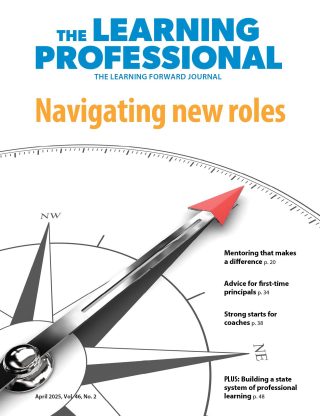The Every Student Succeeds Act (ESSA) calls for interventions funded with federal dollars to be evidence-based. What does this mean for professional learning initiatives that use ESSA funds? We asked Learning Forward Senior Consultant Janice Poda to answer some common questions about the use of evidence according to the federal education law.
Q: What role does research evidence play in ESSA?
A: The Every Student Succeeds Act (ESSA) provides the potential for great strides in supporting teachers and leaders and impacting student outcomes. Two overarching goals that members of Congress had as they crafted the law were to:
- Give states more authority to make decisions about how federal funds are spent, along with flexibility to move funds from one area to another to meet student needs; and
- Encourage states and districts to use proven or promising interventions.
Evidence-based decisions are mandatory in some aspects of the law and strongly encouraged in others. States may spend Title IIA funds on professional learning, although they may also spend those funds on other initiatives such as class size reductions. Those approaches must meet certain standards of evidence.
Evidence-based decision-making may also be required for other aspects of ESSA that affect educator support and capacity-building. One example is a competitive grants priority for school leader recruitment and support programs.
Q: Why is evidence-based decision-making important?
A: There are many reasons to applaud the focus on evidence-based decisions:
- The more we use proven approaches, the more we can improve student outcomes.
- State and local leaders can increase the return on their investments of limited public funds.
- Investing in robust evaluations and transparently sharing results can increase trust and buy-in.
- Leaders are more likely to sustain a strategy if they can point to strong evidence of impact.
- It promotes continuous improvement, builds bodies of evidence, and develops learning systems.
- Policymakers are more likely to continue funding programs that work and produce results.
Q: What does ESSA recognize as evidence?
A: The law acknowledges that evidence comes in multiple forms and that highly rigorous studies are not available for all types of interventions. As a result, it specifies four levels of evidence and encourages states and districts to use the most rigorous type of evidence available.
The top three levels require findings of a statistically significant effect on improving student outcomes or other relevant outcomes:
- Level 1 – Strong evidence: At least one well-designed and well-implemented experimental (i.e. randomized) study.
- Level 2 – Moderate evidence: At least one well-designed and well-implemented quasi-experimental (i.e. matched control group) study.
- Level 3 – Promising evidence: At least one well-designed and well-implemented correlational study with statistical controls for selection bias.

The fourth level is useful when the research base on a particular type of intervention is not well-developed and few or no rigorous studies are available. It consists of interventions that are developing and promising but do not yet have evidence qualifying for the top three levels.
- Level 4 – Evidence-building and under evaluation:
o Demonstrates rationale based on high-quality research or positive evaluation that such activity, strategy, or intervention is likely to improve student outcomes;
o Includes ongoing efforts to examine the effects of such activity, strategy, or intervention.
Q: What steps can educators take to find evidence?
A: More evidence on what works to increase student success is available now than ever before, but education leaders may not have extensive experience accessing that information. Recognizing the time and effort involved in this process, some states are providing research summaries or hiring organizations to make reviewing and selecting interventions easier for districts (Klein, 2018).
For those conducting your own reviews, the following tips can help you get started.
First, conduct a review of the literature and educational research. Select studies that are not older than 1990. Focus on studies in which the participants match or are similar to the students you serve. For example, evidence about a program that has been effective in elementary schools may not have the same impact on high school teachers and students. More evidence about the impact on high school students would be needed before selecting that program for implementation.
When reviewing studies, keep in mind that student achievement (usually measured on standardized tests) is an important metric of success, but not the only one. Educators can also consider the strategies’ alignment with state or national standards, consistency with current statements of experts or professional associations, and other indicators of quality.
Q: How can educators review the evidence?
A: One of the best tools to use to determine where and when to collect and use evidence is the Plan-Do-Study-Act cycle. Plan-Do-Study-Act cycles can use and build evidence in multiple ways. Use the questions associated with each phase of the cycle to start using evidence today to help you solve your most vexing problems.
Questions that go with each cycle
Plan:
- What is our goal?
- What is our challenge?
- What does the strongest available evidence recommend for our context?
Do:
- What can we learn from studies about prior implementations?
- How will we know how we’re doing along the way?
- How will we evaluate our impact?
Study:
- How will we address issues throughout implementation?
What do the data tell us? - What explains our successes and setbacks?
Act:
- What changes should we make?
- Have our needs changed since we began addressing this?
- What can others learn from our experience?
Q: Where can I get more information?
A: Additional resources for selecting, evaluating, and using evidence can be found online.
- ESSA home page: www.ed.gov/essa
- Non-Regulatory Guidance: Using Evidence to Strengthen Education Investments: bit.ly/2d0r16s
- Evidence-Building Opportunities Under ESSA: How States Can and Should Generate Evidence to Drive Better Outcomes for Students: chiefsforchange.org/policy-paper/6072
- Evidence-Based Practice and School Improvement: Key Considerations: bit.ly/2GSrq9X
- Regional Education Labs (REL): ies.ed.gov/ncee/edlabs
- RCT-Yes: www.rct-yes.com
- These States Are Leveraging Title II of ESSA to Modernize and Elevate the Teaching Profession: ampr.gs/2LNVkdX
WHERE TO FIND STUDIES
The following websites are helpful resources for finding studies to review:
- What Works Clearinghouse: https://ies.ed.gov/ncee/wwc
- Best Evidence Encyclopedia: www.bestevidence.org
- Evidence for ESSA: www.evidenceforessa.org
References
Klein, A. (2018). Districts aim to wield evidence-based tools in satisfying ESSA on school turnarounds. Education Week, 37(25), 9-11.
Recent Issues
LEARNING DESIGNS
February 2025
How we learn influences what we learn. This issue shares essential...
BUILDING BRIDGES
December 2024
Students benefit when educators bridge the continuum of professional...
CURRICULUM-BASED PROFESSIONAL LEARNING
October 2024
High-quality curriculum requires skilled educators to put it into...
LEARNING TO PIVOT
August 2024
Sometimes new information and situations call for major change. This issue...












